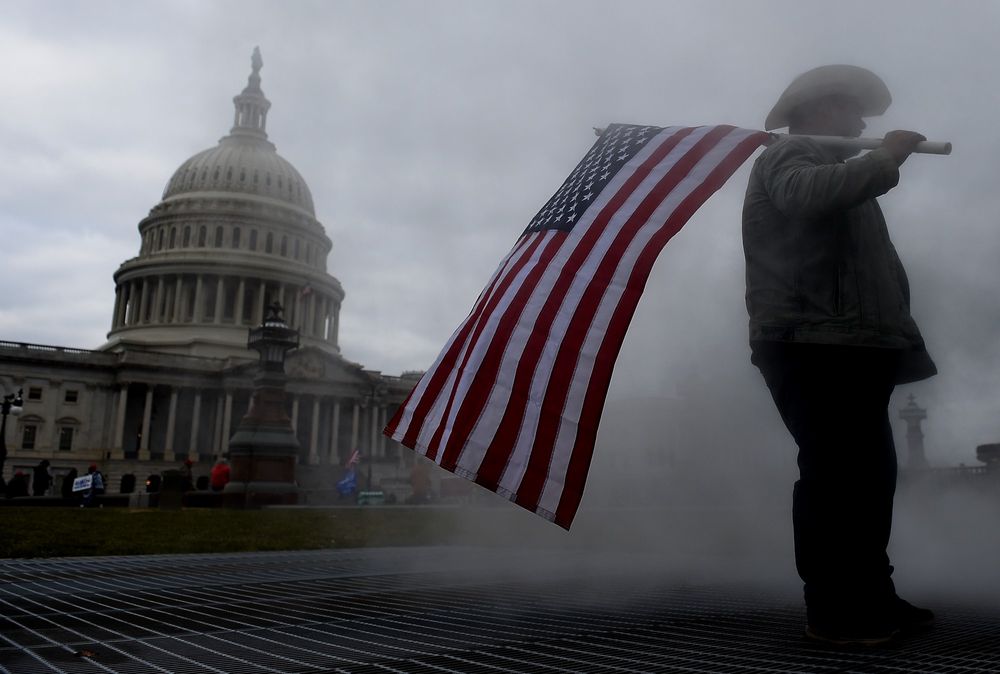Within just two months, the attempted fascist coup by White nationalists caught its first Hollywood green light. Last Thursday, Showtime announced that the network has ordered three scripts about the Trump-incited riot on Capitol Hill for a series to be helmed by Billy Ray, director of political drama The Comey Rule. The three-part act has been made plain: the waning days of the pumpkin presidency, the insurrection, and its aftermath.
The speed with which this happened was as predictable as tax season. Twitter saw it coming from a mile away: A conspiratorial assault called forth by fascist animus and a celebrity president just screams ratings. Bloodshed and White nationalism sell like toilet paper in a pandemic, apparently — with no shortages in sight.
In the Content Era, every event — especially one with Whiteness at its center — is subject to ravaging by the TV and film industry. Yet Showtime’s rush to dramatize the Capitol raid disregards both reality (how can a script be written before the fallout is complete?) and trauma (we literally watched this happen on live TV). Sure, art can help us cope with and remember tragedy in keen ways. But considering how Ray’s past work has trivialized mass death, it’s unlikely that this project will have much to say about fascism that makes us better able to resist its hold on American culture.
We don’t yet know how the scripted version of the insurrection will look. But images of that fateful day are still fresh in the collective memory: the utter glee on the faces of insurgents; Capitol Police Officer Eugene Goodman putting his life on the line to protect members of Congress barricaded in offices; feces-stained portraits, walls, and floors. The Comey Rule dropped in December 2019, one year after former FBI director James Comey — who had publicly inserted himself into the investigations of Hillary Clinton’s emails and Russian political interference in the run-up to Trump’s election — was acquitted by the Department of Justice for leaking a confidential recorded conversation with Trump. Even then, a Vulture review of the show pointed out the strange way Ray handled the quick turnaround, claiming The Comey Rule felt like being “bombarded with information that you’ve already digested elsewhere.” While it’s important to return to the lessons gathered from harrowing experiences, it isn’t additive. At times, it can actually be harmful.
The first episode of The Comey Rule depicts the gory aftermath of the infamous 2016 Pulse nightclub shooting, with James Comey (played by Jeff Daniels) mournfully standing over the bodies of Black and Brown queer people sprawled across the floor. Yet it’s unclear what the scene intends to denote. While the camera cuts around their bodies, Comey’s eyes are closed (perhaps in prayer?) while his rival Rod Rosenstein (Scoot McNairy, who also functions as narrator) commends him for dealing with the real “monsters” of the world in chesty affirmation. Beyond that, the scene serves no other purpose. It’s never referenced again and remains the only occasion in which bloodshed is shown in the series.
While it’s important to return to the lessons gathered from harrowing experiences, it isn’t additive. At times, it can actually be harmful.
Interestingly, the Pulse nightclub shooting is considered one of Comey’s biggest failures; the shooter’s wife, Noor Salman, was never charged with aiding her husband, who was killed that night in a shootout with police. After 18 hours of FBI grilling, threats to take custody of her son, and her own inconsistent written statements, she walked away scot-free. By the time of The Comey Rule’s making, the FBI’s negative public perception following the shooting was already clear. One would think that with some distance from the fiasco, the series might decide to provide a more accurate account of Comey’s public approval.
The aforementioned scene and its historical context are important because those are real victims portrayed, and their deaths are made casual — stepping-stones for White glorification. No, this isn’t a show about the Pulse nightclub shooting; it is about James Comey, the controversial American figure who is of interest only because of his relation to a failing state.
It’s easy to imagine the forthcoming insurrection series imposing a conventional narrative on a government that is prone to fascism — both its impulses and its attacks. The Comey Rule kicks off near the start of the Trump administration, and the new series will seemingly chronicle its violent end. Still, it’s also easy to see Billy Ray’s latest historical reimagining as forgoing the explanation of how fascism takes root. That kind of exploration requires an analysis that begins with the theft of this land, the exploitation of Black labor for wealthy multinational corporations, the notion that only White people have claim to both by birthright, and how inherent those ideas are to the concept of America.
Violence always has a function in American media, because it’s a fundamental ingredient to the crucible of the country’s beginnings. Its depiction also serves a function in either concretizing our trust and celebration of an altogether brutal state or resisting that brutality by being honest about where it originated. It’s easy to imagine that the ending of the insurrection adaptation will carry a sense of mourning appropriate for such a sullen period of history, banking on an all-too-soon shock-value trauma bond.
But it has to be asked: As many juicy subplots as January 6 encompasses, will the TV interpretation have what it takes to become anti-fascist art? If the deaths and terror on that day are to matter, doesn’t it have to be?
